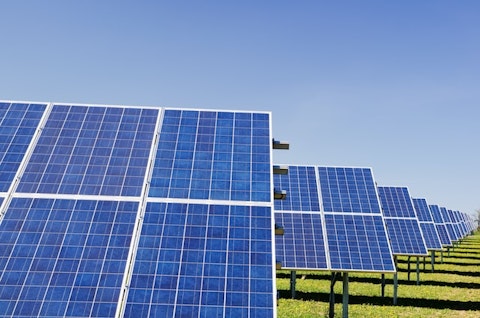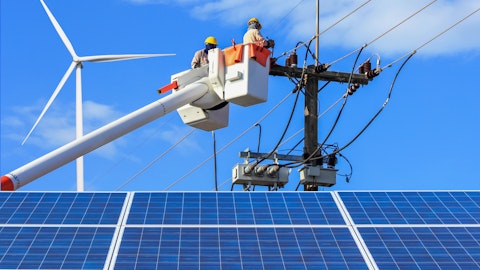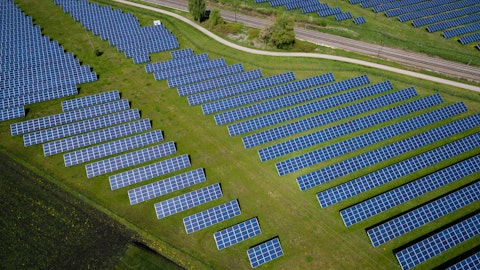Enphase Energy, Inc. (NASDAQ:ENPH) Q4 2022 Earnings Call Transcript February 7, 2023
Operator: Good afternoon and welcome to the Enphase Energy Fourth Quarter 2022 Financial Results Conference Call. Please note today’s event is being recorded. I would now like to turn the conference over to Karen Sagot. Please go ahead.
Karen Sagot: Good afternoon and thank you for joining us on today’s conference call to discuss Enphase Energy’s fourth quarter 2022 results. On today’s call are Badri Kothandaraman, our President and Chief Executive Officer; Mandy Yang, our Chief Financial Officer; and Raghu Belur, our Chief Products Officer. After the market closed today, Enphase issued a press release announcing the results for its fourth quarter ended December 31, 2022. During this conference call, Enphase management will make forward-looking statements, including, but not limited to, statements related to our expected future financial performance, the capabilities of our technology and products and the benefits to homeowners and installers our operations, including manufacturing, customer service and supply and demand, anticipated growth in existing and new markets, the timing of new product introductions and regulatory matters.
These forward-looking statements involve significant risks and uncertainties and our actual results and the timing of events could differ materially from these expectations. For a more complete discussion of the risks and uncertainties, please see our most recent Form 10-K and 10-Qs filed with the SEC. We caution you not to place any undue reliance on forward-looking statements and undertake no duty or obligation to update any forward-looking statements as a result of new information, future events or changes in expectations. Also, please note that financial measures used on this call are expressed on a non-GAAP basis unless otherwise noted and have been adjusted to exclude certain charges. We have provided a reconciliation of these non-GAAP financial measures to GAAP financial measures in our earnings release furnished with the SEC on Form 8-K and which can also be found in the Investor Relations section of our website.
Now, I’d like to introduce Badri Kothandaraman, President and Chief Executive Officer of Enphase Energy. Badri?
Badri Kothandaraman: Good afternoon and thank you for joining us today to discuss our fourth quarter 2022 financial results. We had a good quarter. We reported record quarterly revenue of $724.7 million, shipped approximately 4.9 million microinverters and 122-megawatt hours of batteries and generated free cash flow of $237.3 million. Approximately 55% of our Q4 microinverter shipments were IQ8. We exited the fourth quarter at 44% gross margin, 12% operating expenses and 32% operating income, all as a percentage of revenue on a non-GAAP basis. Mandy will go into our financials later in the call. Let’s now discuss how we are servicing customers. Our Q4 net promoter score worldwide was 71% compared to 70% in Q3. Our North American net promoter score was 74% compared to 71% in Q3.
Our average call rate time was quite down to 1.6 minutes compared to 4.8 minutes in Q3. We started our teams well, focused on root cause, fixes of customer issues and improved our business processes. Let’s talk about microinverter manufacturing. Our overall supply environment remains quite stable in general. There are issues that crop up from time-to-time. Our teams are staying on top of them. Our quarterly capacity was 5 million microinverters exiting Q4. We are on track to begin manufacturing at Flex Romania starting this quarter, enabling us to service Europe better. This will enable a total quarterly capacity of 6 million microinverters exiting Q1. We are going to increase this capacity even more with U.S. manufacturing. Let’s cover that now.
As we discussed last quarter, we are pleased that the IRA will help bring back high-tech manufacturing to the U.S. and stimulate the economy through the creation of jobs. We are excited to service the U.S. customers better with local manufacturing. We plan to begin U.S. manufacturing of our microinverters in the second quarter of 2023 with a new contract manufacturing partner and in the second half of 2023 with our two existing contract manufacturing partners. We plan to open 6 manufacturing lines by the end of this year adding a quarterly capacity of 4.5 million microinverters, bringing our total quarterly capacity to more than 10 million microinverters as we exit 2023. We continue to await the details of IRA implementation from the U.S. Department of Treasury.
Let’s cover the regions. Our U.S. and international revenue mix for Q4 was 71% and 29% respectively. In the U.S., our revenue increased 15% sequentially and 59% year-on-year. We had record quarterly revenue, record quarterly sell-through for our microinverters and record quarterly installer count in the fourth quarter. Our microinverter channel inventory was quite healthy at the end of the fourth quarter, while our storage channel inventory was a little elevated. I will go into more details about our batteries later in the call. In Europe, our revenue increased 21% sequentially and more than 130% year-on-year, led by strong demand in Netherlands, France, Germany, Belgium, Spain, Portugal and the UK. We had record sell-through and record installer count in Q4 as we continue to grow our business.
We started shipping our IQ8 microinverters into Netherlands and France in Q4. We are working hard to introduce IQ8 into other European countries shortly. Also, we are currently shipping IQ batteries into Germany and Belgium. We expect to start shipping IQ batteries into Austria, France, Netherlands and Spain in the first half of this year. Our GreenCom Networks acquisition, which closed in the fourth quarter helps to integrate Enphase microinverters and batteries with third-party EV chargers and heat pumps, enabling homeowners to control their devices from one app, which is the Enphase App. We are integrating the GreenCom offering with the Enphase ecosystem and expect to make it available to our European installers shortly. Now I will provide some color on Latin America, Australia and Brazil.
In Latin America, our revenue doubled year-on-year. We had steady growth in our solar plus storage business in Puerto Rico during 2020. In Australia, the solar market continued to recover in Q4 after a weak first half of the year. We expect to introduce IQ batteries in Australia, along with IQ8 microinverters in the second quarter of 23. As for Brazil, we experienced significant quarter-over-quarter revenue growth as we saw increased deployment of our IQ7 family of microinverters. The residential solar market in Brazil continues to grow rapidly. We have a very strong team in place. And we are excited about our future growth in the country. The emerging residential markets in Brazil, Mexico, Spain and India are all moving to high-wattage panels.
In order to service them better, we plan to introduce a high-power 480 watt AC microinverter in the second quarter. Let’s discuss our overall company outlook for Q1. We expect our Q1 revenue for the company to be within a range of $700 million to $740 million. We are fully booked for Q1 right now. Let me provide some additional information on the key regions, first about Europe, then about the U.S. Our Europe business is doing very is very strong as I noted. Note that we also doubled our revenue from 2020 to 2021 and more than doubled again from 21 to 22. We have a strong team in place and are quite bullish about 2023. We expect to introduce IQ batteries and IQ8 microinverters into many more countries in Europe as we progress through the year.
Our value proposition is our differentiated home energy management systems, combined with high quality and great customer experience. As for Q1, we expect healthy growth compared to Q4, consistent with the overall growth in the European market. Let’s now cover the U.S. We expect our U.S. business to be slightly down in Q1 compared to Q4, primarily driven by seasonality and the macroeconomic environment. We are seeing that our distributor and installer partners are a little more cautious in booking orders. We normally have a 6-month order visibility and that has been somewhat reduced as our partners watch their spending closely. On the sell-through of our microinverters, while December was quite strong for us we saw a more pronounced seasonality in January than normal.
There are a couple of interesting observations I thought I will share with you. Even with the pronounced seasonality and sell-through in January, we would like to point out that our activations are holding up. The second point to also note is that in conversations with our installers and distributor partners, they have started to see originations pickup in January when compared to December. Although the data we have is limited, these two points make us cautiously optimistic about Q2. We have also seen some analyst reports about a possible shift from loans to PPA due to the high prevailing interest rates. We work with thousands of installers every quarter. Our installer base is very diverse, both small and large installers that offer cash, loans and PPA options to homeowners.

Photo by Zbynek Burival on Unsplash
Any shift from one type of financing to another only has a minor impact to our business, almost negligible. No matter what the conditions are, our approach at Enphase does not change. We manage for the long-term. The basic thesis ongoing solar and storage remains intact, aided by a few factors: first, the utility rates, which are rising in many states across the U.S.; second, the 30% ITC tax credit, which has been extended for 10 years with the IRA; and third, the desire for energy independence and tackling climate change. At Enphase, we will continue to make best-in-class home energy systems with a laser focus on product innovation, quality and customer experience. Let’s switch to talking about battery. We shipped 122-megawatt hours of IQ batteries in Q4.
We have now certified approximately 2,300 installers worldwide since the introduction of IQ batteries into North America, Germany and Belgium. Our installers in North America experienced a median commissioning time of 91 minutes exiting Q4 compared to 118 in Q3. We made significant software changes to improve communication, grid transitions and commissioning time, and I am quite happy with the performance of the team. As a result, we saw slightly higher sell-through of our batteries in Q4 versus Q3. We have also got a number of feedbacks from the installers about the fact of improved performance in terms of commissioning. We plan to ship 100 to 120-megawatt hours of IQ batteries in Q1. We also expect to start ramping our third generation IQ battery in North America and Australia in the second quarter.
This battery has got 5-kilowatt hour modularity, 2x the power compared to our existing battery and 30-minute commissioning time in addition to being easier to install and service. We expect the higher charge discharge rate as well as the 5-kilowatt hour modularity to be uniquely beneficial to the homeowners under the upcoming NEM 3.0 tariff in California. With the significant changes we are making to our IQ batteries, we are confident that storage installations will become as efficient as microinverters. And as a result, the profitability for installers should get better. We expect our battery business to perform well in the second half of the year, both due to our third generation battery as well as NEM 3.0 adoption in California. Let’s now talk about our product for the small commercial solar market in the U.S. We are on track to pilot the IQ8P product and release it to production in the second half of the year.
As our panel power continues to increase rapidly, we are increasing the power of the microinverter by 50% from 320 watts to 480 watts AC while sticking to the single panel architecture. This product as well as the 480 watt residential microinverter for emerging markets share the same design. Let’s discuss EV chargers. We shipped approximately 7,600 EV chargers in Q4 as compared to 6,370 charges in Q3. We began manufacturing Enphase branded EV chargers at our contract manufacturing facility in Mexico this quarter, helping us to increase capacity and reduce costs. We expect to introduce IQ smart EV chargers to customers in the U.S. in the second quarter. These chargers will provide connectivity and control, enabling use cases like green charging and allow homeowners visibility into the operation of their Enphase solar plus storage plus EV charger system through the app.
We recently demonstrated our bidirectional EV charger technology combining vehicle-to-home, vehicle to grid and green charging functionality. This new bidirectional EV charger, along with Enphase’s solar and battery storage can all be controlled from the Enphase app, empowering homeowners to make use, safe and sell their own power. We are working with standards organization, EV manufacturers and regulators to bring this technology to market in 2024. Let me give you a quick update on our Enphase Installer Network, or EIN. We have now onboarded more than 1,300 installers to our EIN worldwide through a highly selective process focused on installed quality and exceptional experience to homeowners across the globe. Let’s discuss the installer platform.
We made several updates to the Solargraf design and proposal software during the fourth quarter, incorporating battery design and proposal, document management, consumption modeling and several other improvements as requested by our installer partners. In addition, we made significant strides in automating the creation of permit plan sets with Solargraf software. We now have over 1,000 installers using Solargraf software. Next, I’d like to comment on NEM 3.0 in California. The CPUC has finalized its decision on NEM 3.0 in Q4. While we wish the export rates had been stepped down a little more gradually, the policy is generally in the right direction for incentivizing homeowners to adopt storage. The next step is for installers to educate homeowners to increase adoption of NEM 3.0 and companies like Enphase need to help in making this transition possible.
That’s where Solargraf’s design and proposal engine comes in. Installers will be able to use Solargraf to provide homeowners with a proposal that optimizes their bills under NEM 3.0 tariff to minimize payback and maximize ROI. The advantage with Solargraf is that the underlying algorithm used by will be the same as what is used in the actual operation of the Enphase home energy system. As the system complexity increases with solar, batteries, EV chargers and dynamic rate structures such as NEM 3.0, the tight coupling of Solargraf and actual product operation will maximize value to homeowners. In summary, we are quite pleased with our performance. As a reminder, our strategy is to build best-in-class home energy systems and deliver them to homeowners through our installer and distributor partners, enabled by the installer platform.
We have many new products that are coming out in 2023 that will increase our served available market and positively contribute to the top line. We look forward to introducing IQ8 microinverters worldwide, introducing IQ batteries into more countries in Europe, launching our third generation battery in North America and Australia as well as introducing our highest power 480-watt IQ8P microinverter for both the U.S. small commercial and emerging residential markets. We are also excited about the upcoming Solargraf functionality, especially the NEM 3.0 functionality and finally, the work we are doing to bring both smart EV chargers as well as bidirectional EV charging capabilities to the market. With that, I will now turn the call to Mandy for a review of our financials.
Mandy?
Mandy Yang: Thanks, Badri and good afternoon, everyone. I will provide more details related to our fourth quarter of 2022 financial results as well as our business outlook for the first quarter of 2023. We have provided reconciliations of these non-GAAP to GAAP financial measures in our earnings release posted today, which can also be found in the IR section of our website. Total revenue for Q4 was $724.7 million, representing an increase of 14% sequentially and a quarterly record. We shipped approximately 1,952.4 megawatts DC of microinverters and 122.1 megawatt hours of IQ batteries in the quarter. Non-GAAP gross margin for Q4 was 43.8% compared to 42.9% in Q3. The increase was driven by a favorable IQ8 product mix. GAAP gross margin was 42.9% for Q4.
Non-GAAP operating expenses were $87.7 million for Q4 compared to $78.6 million for Q3. The increase was driven by international growth, customer service and R&D. GAAP operating expenses were $153.7 million for Q4 compared to $132.5 million for Q3. GAAP operating expenses for Q4 included $59.4 million of stock-based compensation expenses and $4.9 million of acquisition-related expenses and amortization for acquired intangible assets and $1.8 million of restructuring and asset impairment charges. On a non-GAAP basis, income from operations for Q4 was $229.4 million compared to $194 million for Q3. On a GAAP basis, income from operations was $157 million for Q4 compared to $135.4 million for Q3. On a non-GAAP basis, net income for Q4 was $212.4 million compared to $175.5 million for Q3.
This resulted in non-GAAP diluted earnings per share of $1.51 for Q4 compared to $1.25 for Q3. GAAP net income for Q4 was $153.8 million compared to GAAP net income of $114.8 million for Q3. This resulted in GAAP diluted earnings per share of $1.06 for Q4 compared to $0.80 for Q3. We exited Q4 with a total cash, cash equivalent and marketable securities balance of $1.61 billion compared to $1.42 billion at the end of Q3. In Q4, we generated $253.7 million in cash flow from operations and $237.3 million in free cash flow. Capital expenditure was $16.4 million for Q4 compared to $8.9 million for Q3. The increase was primarily due to investment in additional contract manufacturing sites and R&D equipment. Capital expenditure for the full year of 2022 was $46.4 million.
Now, let’s discuss our outlook for the first quarter of 2023. We expect our revenue for the first quarter of 2023 to be within the range of $700 million to $740 million, which includes shipments of 100 to 120-megawatt hours of IQ batteries. We expect GAAP gross margin to be within the range of 40% to 43% and non-GAAP gross margin to be within the range of 41% to 44%, which excludes stock-based compensation expenses and acquisition-related amortization. We assume a conservative euro FX rate in our Q1 guidance, and we don’t expect significant impact to our financials from fluctuations in FX rates. We setup our GAAP operating expenses to be within the range of $177 million to $181 million, including approximately $77 million estimated for stock-based compensation expenses, restructuring charges for site consolidation, acquisition-related expenses and amortization.
We expect our non-GAAP operating expenses to be within a range of $100 million to $104 million. Moving to tax. Since we have utilized most of our net operating loss and research tax credit carry-forwards in 2022, we announced a significant U.S. cash taxpayer. We expect GAAP and non-GAAP annualized effective tax rate for 2023 to be at 22% plus or minus 2% before any IRA impact. In closing, we are pleased with our 2022 financial performance. We grew our revenue by 59% year-over-year, while spending on non-GAAP gross margin to 42.6% in 2022. We increased non-GAAP diluted earnings per share by 92% to $4.62 per share in 2022 and generated record free cash flow of $698.4 million more than double from 2021. With that, I will now open the line for questions.
See also Buffett Stock Portfolio: Recent Buys and 13 Best Value Dividend Stocks to Buy .
Q&A Session
Follow Enphase Energy Inc. (NASDAQ:ENPH)
Follow Enphase Energy Inc. (NASDAQ:ENPH)
Operator: Our first question will come from Colin Rusch of Oppenheimer. Please go ahead.
Colin Rusch: Thanks so much, guys. I appreciate all the detail here. Can you talk about what your how your pricing strategy is evolving here as you move into different configurations for the devices, and you continue to try to monetize the value here. Are there areas where you can increase price a little bit? Are you trying to hold it flat? Just talk to us about how that’s evolving here.
Badri Kothandaraman: Yes. The pricing in general right now is very stable. We do value-based pricing. We look at pricing versus the next best alternative. And we usually look at what value do we add in compared to that alternative. And typically, the things we focus on for microinverters are how is our quality compared to competition with our customer experience compared to competition. How is our ease of use compared to competition is the product a lot more easier to install and that matters to the installers and they once they install, they do not want to come back to that site again. So they need excellent support. So if we look at all of these puts and takes, and we look at it versus the next best alternative. We price our products.
We are extremely disciplined. There we also have a segmentation strategy, which means that we look at different flavors of power, and we price it according to the value those provide. In batteries, our strategy has been similar with the first two products in our generation, first generation and second-generation batteries, we fell a little bit short in terms of the differentiating features. And now with the third generation, I think we are going to be quite unique. We have modularity of 5-kilowatt hours, we will have double the power compared to the prior generation, which means a 5-kilowatt hour battery will have 3.84 kilowatts of continuous power and 7.68 kilowatts of peak power, which is amazing power. And then in addition, that’s going to have 30 minutes commissioning time, the thing that we didn’t get right on the first two generations.
So with batteries, we are back into the value space, again, and we will price those products accordingly. So the short answer to your question, pricing is quite stable now.
Colin Rusch: Okay. Excellent. And then as you look at making a bigger push into the commercial rooftop market, can you talk a little bit about the preparation in the channel in terms of education and training on the product, what you’re seeing already in terms of sell-through with some of the legacy products as you prepare to really get into full swing by the middle or latter part of the year?
Badri Kothandaraman: Right. This product, we had originally 3 years ago, we started with introducing the IQ8D product. And that at that time was a good idea. It was 640-watt AC. And that microinverter covered two panels. And we got excited by that. We’ve worked on it. And that product, it took us some time to work on it because not only we had to get the microinverter right, we had to get the entire chain right, which is the microinverter performance, the gateway performance, most important, the software performance. And then we needed a proper design and proposal inject light Solargraf. So it took us quite a bit of time. And then we realized a few months ago that, yes, we can come with that product, we can release that product out, but that product is going to fall short in terms of power because the panel power in the commercial business has moved to, let’s say, greater than 500 watts.





